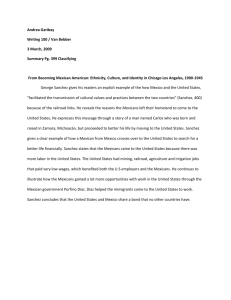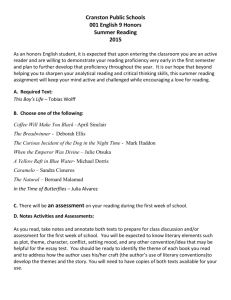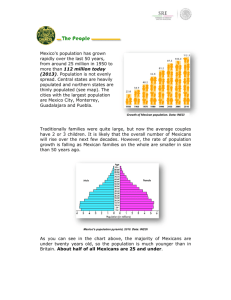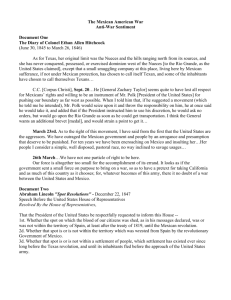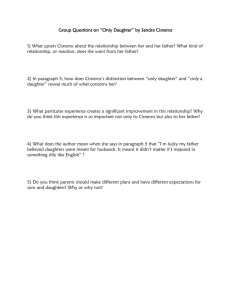Caramelo book guide
advertisement
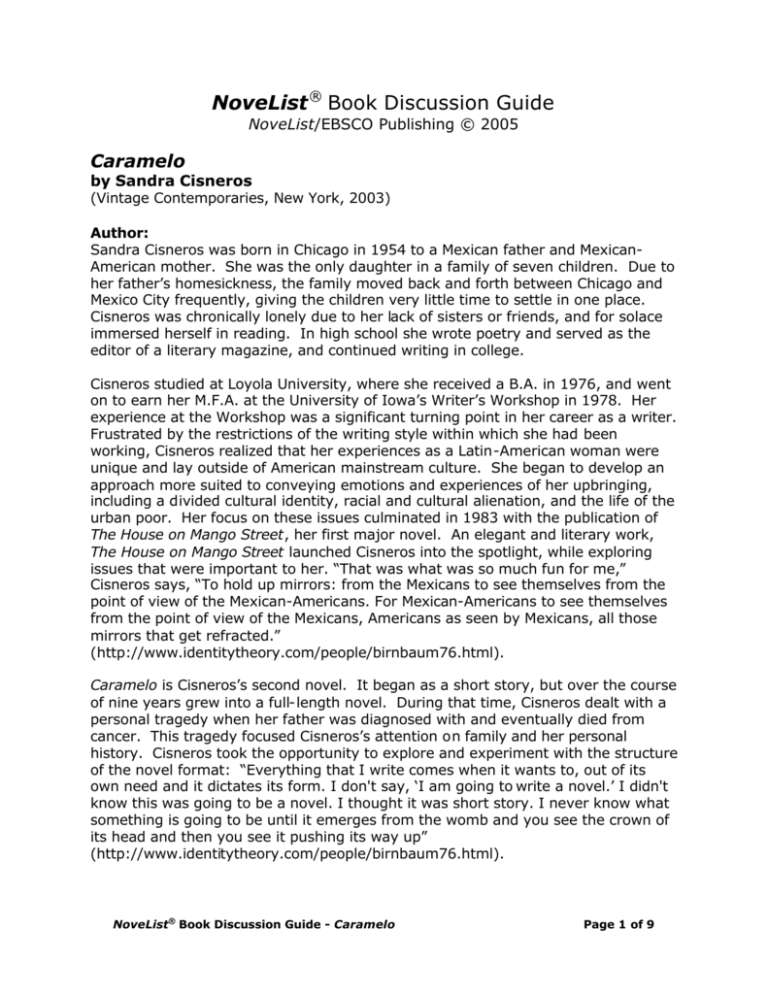
NoveList ® Book Discussion Guide NoveList/EBSCO Publishing © 2005 Caramelo by Sandra Cisneros (Vintage Contemporaries, New York, 2003) Author: Sandra Cisneros was born in Chicago in 1954 to a Mexican father and MexicanAmerican mother. She was the only daughter in a family of seven children. Due to her father’s homesickness, the family moved back and forth between Chicago and Mexico City frequently, giving the children very little time to settle in one place. Cisneros was chronically lonely due to her lack of sisters or friends, and for solace immersed herself in reading. In high school she wrote poetry and served as the editor of a literary magazine, and continued writing in college. Cisneros studied at Loyola University, where she received a B.A. in 1976, and went on to earn her M.F.A. at the University of Iowa’s Writer’s Workshop in 1978. Her experience at the Workshop was a significant turning point in her career as a writer. Frustrated by the restrictions of the writing style within which she had been working, Cisneros realized that her experiences as a Latin-American woman were unique and lay outside of American mainstream culture. She began to develop an approach more suited to conveying emotions and experiences of her upbringing, including a divided cultural identity, racial and cultural alienation, and the life of the urban poor. Her focus on these issues culminated in 1983 with the publication of The House on Mango Street, her first major novel. An elegant and literary work, The House on Mango Street launched Cisneros into the spotlight, while exploring issues that were important to her. “That was what was so much fun for me,” Cisneros says, “To hold up mirrors: from the Mexicans to see themselves from the point of view of the Mexican-Americans. For Mexican-Americans to see themselves from the point of view of the Mexicans, Americans as seen by Mexicans, all those mirrors that get refracted.” (http://www.identitytheory.com/people/birnbaum76.html). Caramelo is Cisneros’s second novel. It began as a short story, but over the course of nine years grew into a full-length novel. During that time, Cisneros dealt with a personal tragedy when her father was diagnosed with and eventually died from cancer. This tragedy focused Cisneros’s attention on family and her personal history. Cisneros took the opportunity to explore and experiment with the structure of the novel format: “Everything that I write comes when it wants to, out of its own need and it dictates its form. I don't say, ‘I am going to write a novel.’ I didn't know this was going to be a novel. I thought it was short story. I never know what something is going to be until it emerges from the womb and you see the crown of its head and then you see it pushing its way up” (http://www.identitytheory.com/people/birnbaum76.html). NoveList® Book Discussion Guide - Caramelo Page 1 of 9 Early family pressure to assume a traditional feminine role led to a very feminist tone in Cisneros’s writing. Her work often deals with women who seek personal independence and self-determination, and her poetry in particular celebrates the often-maligned sexuality of women. Her work features characters who, for reasons of race or poverty, are invisible to the larger world. While never frankly autobiographical, Cisneros does write about what she has lived, exploring Mexico City, Chicago, and places the author visited during her travels in Europe. In addition to her writing, Cisneros has also been a guest lecturer at California State University, University of California, Berkeley, University of California, Irvine, University of Michigan, Ann Arbor and the University of New Mexico, Albuquerque. She has also taught at the Latino Youth Alternative High School in Chicago and has been a college recruiter and counselor for minority students at Loyola University of Chicago. She served as literature director for the Guadalupe Cultural Arts Center in San Antonio, Texas, and was an artist in residence at the Foundation Michael Karolyi in Vence, France. In addition to The House on Mango Street and Caramelo, she is also the author of two books of poetry, Loose Women and My Wicked, Wicked Ways, and a children’s book called Hairs/Pelitos. Summary: The story begins with the Reyes family’s annual trip to Mexico City. Every year Celaya “Lala” Reyes, her parents Inocencio and Zoila, her six older brothers, and various aunts and uncles pack themselves into an assortment of automobiles and drive from their home in Chicago to Lala’s paternal grandparents’ house in Mexico City. The story is narrated by Lala, the youngest child, who throughout the trip is often drowned out by her boisterous brothers and the constant bickering of her parents. When the family finally reaches Awful Grandmother’s house, other family members from Mexico are introduced. The children feel increasingly pulled between the Mexican and American aspects of their identities. Lala undergoes an emotional transformation as her Mexican identity begins to reassert itself. At the family’s beach house, Lala becomes fascinated with one of the maids, Candelaria. Through her, Lala begins to explore cultural perceptions of beauty. Numerous family arguments also take place, many between Lala’s father and Awful Grandmother. The story then moves into a conversation between Lala and Awful Grandmother, in which Lala tells her Grandmother’s life story in an attempt to discover how she became Awful. With occasional interjections from her grandmother, Lala begins to recount the story of her grandmother’s youth, marriage, and move to the United States against the backdrop of revolutionary Mexico. After completing Grandmother’s story, the story moves to other members of the family throughout the twentieth century and on both sides of the border. These stories explain how the Reyes family came to have a foot in both worlds, and how this created conflicting identities in each family member. NoveList® Book Discussion Guide - Caramelo Page 2 of 9 The third and final section of the novel explores the relationship between Lala’s parents, as they move their family from Chicago to San Antonio, Texas. The family has problems trying to relocate their business and finding a suitable house. Lala and her father visit the local Catholic parochial school and convince the administration that Lala’s family is poor and unable to provide her with a Catholic education. Impressed by their feigned piety, the school allows her to attend free of charge in return for having Lala doing housework part-time at the rectory. Lala finds her sense of identity challenged yet again in this new environment. She begins to feel tension between her budding sexuality and the strict Catholic morals that are being taught in her school. She has a hard time fitting in with other students, in part due to her ambiguous identity. Lala finds a new friend in Viviana Ozuna, “Viv” to her friends. Viv is everything Lala is not: outgoing, sexually precocious, confident. They have a variety of adventures together, including getting arrested for shoplifting, and they make plans to move to San Francisco and become songwriters after graduation. Lala also meets Ernesto, a young man with whom she falls in love. The affair intensifies, and they discuss marriage. Ernesto eventually rejects this option, and Lala, when he begins to feel torn between his sexual relationship with Lala and his strong Catholic values. At home, the family faces a crisis when Inocencio has a heart attack and is hospitalized. He recovers, and the story ends with the party Lala and her siblings throw for their parents’ thirtieth wedding anniversary. Questions While answers are provided, there is no presumption that you have been given the last word. Readers bring their own personalities to the books that they are examining. What is obvious and compelling to one reader may be invisible to the next. The questions that have been selected provide one reasonable access to the text; the answers are intended to give you examples of what a reflective reader might think. The variety of possible answers is one of the reasons we find book discussions such a rewarding activity. Why does Cisneros include footnotes? In general, the footnotes are used to explain events and people mentioned in the main story. Many of them relate events from Mexican history, most of which focus on interaction with the United States. “For the longest time, I thought the eagle and the serpent on the Mexican flag were the United States and Mexico fighting,” Lala says. (p. 235). Most of the events are violent: the occupation of the port of Tampico by US Marines in 1914, the massacre of Mexican-American farmers by Texas Rangers in 1915. The role of Mexican soldiers and airmen in the Second World War is also discussed. These events loom large in Mexico’s history, but most Americans are unaware that they ever took place. Other footnotes explain references in the novel to Mexican and Mexican-American celebrities. While these people were apparently well known in popular culture during the 1950’s and 1960’s, they are now forgotten by mainstream America, much like the historical incidents. For example, after Inocencio first comes to the US, he spends the night in jail. There he meets Wenceslao Moreno, a talented NoveList® Book Discussion Guide - Caramelo Page 3 of 9 ventriloquist who was famous in 1950’s and 1960’s. He appeared many times on the Ed Sullivan Show, made some movies, and is now almost forgotten in the U.S. (pp. 214-221). Cisneros is revealing the invisible history of Mexico and the United States, and how easy it is for the dominant nation to forget about its less powerful neighbors. This is further emphasized by the timeline at the end of the book, which traces Mexican history from 1519 to 2002. As a literary device, this serves to underscore the theme of things constantly present yet unnoticed that runs through the novel. Why does the author use so many Spanish words and phrases? Cisneros’s use of the Spanish language establishes a sense of place and context. For example: While the family is in Chicago, Spanish is used exclusively in the home or with other members of the Chicano community. While visiting Mexico, however, the use of the language expands to include the world outside the home and family, highlighting the difference between the two environments. Cisneros also uses more Spanish names for places and things in the sections of the novel that take place in Mexico, building a sense of “local color.” As soon as we cross the bridge, everything switches to another language. Toc, says the light switch in this country, at home it says click. Honk, say the cars at home, here they say tan-tan-tan. The scrip scrape scrip of high heels across the saltillo floor tiles. …The pic pic pic of someone’s faraway hammer. (p. 17) The Reyes family’s interaction and the role each member assumes are also shaped by the language they use. The children are frequently addressed as ‘mijo’ or ‘mija,’ a contraction of ‘mi hijo/hija,’ my child. When Lala’s older brother returns from a year in Mexico, this becomes clearer: “He tries talking to us in Spanish, but we don’t use that language with kids, we only use it with grown ups. We ignore him and go back to watching cartoons” (p. 23). For the younger children, Spanish may be the language used with la familia or while in Mexico, but their day-to-day lives, and their connection to the greater world, are in English. How does the rebozo, or shawl, represent Mexico and the Mexican experience? A rebozo is the traditional silk shawl worn by Mexican women of all classes. Traditionally a coming-of-age present for young women, they are being worn less and less as time goes on. The rebozo in many ways serves as a metaphor for Mexican history. It is present throughout Mexican society, but its origins are a diverse mix of influences from around the world. A combination of Spanish, Indian, and even Chinese sources has contributed to its development, and it has evolved over history as new influences are absorbed and Mexican identity and culture develop. Just as the Mexican people are mostly mestizo, mixed, so is the rebozo. In this way it also serves as a symbol of Cisneros’s literary technique. Caramelo is a collection of stories, woven together. The rebozo also serves as a symbol of the feminine in Mexican society. They are traditionally worn by all women over a NoveList® Book Discussion Guide - Caramelo Page 4 of 9 certain age, and are often passed as heirlooms from mother to daughter. They are unnoticed, yet fulfill many different roles: shawl, apron, scarf, headdress, baby sling and tablecloth. In the past, the way a woman wore one signaled her status: married, single, prostitute. During the family’s visit to Mexico, there is some discussion about finding a rebozo for Lala. Awful Grandmother is resistant to the idea, pointing out that things have changed: No use spending on something she can’t even wear till she grows up. And what if she grows up and doesn’t even want to wear it. Then what, eh? So that she can save it for her funeral? Over there on the other side do they even wear them? I don’t think so. They’re too modern. In another generation they’ll look on them as rags, barbarities, something to spread on a table or, God forbid, a bed. If you find a real silk one, better buy it for your mother. I’m the only one who knows the true worth of a silk rebozo around here. (p. 39) Several things are suggested by this outburst. The rebozo is falling out of use as the idea of Mexican womanhood evolves. In this chapter it is revealed that true silk rebozos are hard to find, having been replaced by cheaper factory ones. It also suggests that the role and identity of women in the Reyes family has changed in the U.S., moving away from tradition. This serves to underscore some of the tension Lala feels between her Mexican cultural roots and her contemporary American identity. In the final section of the novel, she wears her grandmother’s rebozo at a party she and her siblings have thrown for their parent’s thirtieth wedding anniversary in San Antonio. This suggests a resolution or at least an acceptance of these two facets of her identity. How does the novel portray gender roles? Cisneros portrays the feminine in Mexican society as being consistently repressed. Women are ever present, yet unnoticed, drawing a parallel to the novel’s treatment of the role of Mexicans in American history. The idea that women could have independence and identity is unheard of. Lala’s mother tells her, “If you leave your father’s house without a husband, you are worse than a dog. You aren’t my daughter, you aren’t a Reyes…. If you leave alone you leave like, and forgive me for saying this but it’s true, como una prostituta. Is that what you want the world to think?” (p 360). Awful Grandmother has a similar experience in Chapter 70, when her worth and identity are irrevocably tied to her sexuality: The Grandmother only became visible when her body changed and garnered the trophy of man’s attentions. But then she had lost their attention as her body shifted and slouched into disrepair after the birth of each child. And when she no longer was vain and cared about taking care of herself, she began to disappear. Men no longer looked NoveList® Book Discussion Guide - Caramelo Page 5 of 9 at her; society no longer gave her much importance after her role of mothering was over. (p 347) Mexican culture values women only in their role as mothers. The domineering nature of Awful Grandmother and the hold she has over her children are the best examples of this. Awful Grandmother also places more value on her sons than her daughters, a practice portrayed as typical in Mexico. As Lala observes of Mexican families, “their mamas are the most devoted of mamas....when it comes to their sons." (p. 195). The tension Inocencio feels between his role as a husband and his duty as a son are also good examples. Zoila often addresses her husband as ‘mijo’, my son. (p. 307). While women are most appreciated for their beauty and sexual desirability, chastity is expected and any expression of female sexuality is taboo. Lala experiences this during her time in Catholic school in San Antonio. She is unsure as to how to present herself during an in-class discussion on sexual morals: “Pretend like I’m a puta or pretend I’m la Virgen de Guadalupe. Which is worse?” (p. 325). Her guilt over her first sexual experiences is also indicative of the cultural attitude toward women’s sexuality: “When I breathe, my head hurts. Prostituta. Puta. Perra. Perdida” (p. 360). Lala’s sexuality also creates tension between Lala and her family. After Lala scandalously attempts to elope with her boyfriend, her family is unsure of how to respond. “Nobody mentions my ‘abduction.’ The more they don’t mention it, the more it’s obvious. …I feel like I’m dragging around a clubfoot. Everybody refuses to look at me, and that just makes it worse” (p. 399). The people closest to Lala don’t know how to treat her now that she has broken ranks with the standards of their culture. How does the Reyes family change as a result of moving between Mexico and the United States? The Reyes’ identity shifts away from Mexico and toward the United States over the course of the novel. The Awful Grandmother’s story, as related by Lala, is in many ways the story of Mexico at the time, full of revolution and upheaval. Her son Inocencio is born in a Mexico that is proud to be Mexican, where we are told “…the arts flourished, creating a new mestizo identity…” (p. 206). He moves to the U.S. as a young man, struggles to learn English, serves in the American military, and establishes himself finally in Chicago. This does not prevent him from having a confrontation with Immigration as a middle-aged man. Agents from la Migra confront Inocencio at his business and demand to see proof of his American citizenship or legal residency. This is after he has been legally in the U.S. for decades (pp. 372-378). Lala has similar issues. While on some visceral level she responds to Mexico during her family’s visits, she never fully feels comfortable there (pp. 16-18). She has problems with her identity in the U.S. as well. Her schoolmates in San Antonio embrace their Chicana identity, while Lala still feels torn between two selves. This creates problems for her at school when she is accused of not being Mexican enough. She outlines this tension and conflict in Chapter 72. While her NoveList® Book Discussion Guide - Caramelo Page 6 of 9 schoolmates are focused on their Chicana identity, Lala’s visits to Mexico give her a greater understanding of what it means to be Mexican: If you’ve never been south of Laredo, how the hell would you know what Mexicans are supposed to look like? There are green-eyed Mexicans. The rich blond Mexicans. The Mexicans with the faces of Arab sheiks. The Jewish Mexicans. The big-footed-as-a-German Mexicans. The leftover-French Mexicans. The chaparrito compact Mexicans. The Tarahumara tall-as-a-desert-saguaro Mexicans. The Mediterranean Mexicans. The Mexicans with Tunisian eyebrows. The Chinese Mexicans…I don’t know what you’re talking about when you say I don’t look Mexican. I am Mexican. Even though I was born on the U.S. side of the border. (p. 353) Just as Lala’s personal identity is multifaceted, composed of both Mexican and American elements, so is Mexican identity composed of a variety of ethnic and physical types. Since the novel deals to a great extent with the interplay of Mexican and American identities, Cisneros may be suggesting that American identity too is far from homogenous. What role does religion play in the novel? Religion is one of the devices the author uses to convey the changing attitudes and beliefs of each generation of the family. Awful Grandmother is very religious. She visited the church frequently to pray while she was pregnant: “If her baby was a boy, Soledad vowed she would love him like La Virgen and name him Inocencio” (p. 191). Her speech is filled with religious language and Bible references. Her house is decorated with votive candles and religious icons. In contrast, Inocencio’s wife Zoila is “a Godless Woman” (p. 311), and runs her household accordingly: In our house votive candles never flicker from bedroom bureaus night and day. No chubby statue of the baby Jesus dressed as the Santo Niño de Atocha…has ever paid us a call. No one burns copal incense for the souls condemned to purgatory or for the souls condemned to life. No dusty rosary swings across the wall above our beds. No Palm Sunday cross collects grease above the kitchen door. No guardian angel protects us while we dream. (p. 311) When Zoila and Inocencio were first married, Awful Grandmother sent them a framed portrait of the Virgin of Guadalupe, along with the request that it hang in their bedroom. Zoila objected, but Inocencio insisted, more out of loyalty to his mother than any religious feeling. The family rarely attends church: “On Sunday mornings other families go to church. We go to Maxwell Street” (p. 294). Dressed in his good clothes, Inocencio leads the family to the Maxwell Street flea market. NoveList® Book Discussion Guide - Caramelo Page 7 of 9 After they move to San Antonio, Lala and her father visit the local priest. “Every time we move to a new neighborhood, Father and I have to call on the priest. Just once and never again” (p. 318). The true motive of the visit becomes clear: To get a tuition break at Resurrection and Immaculate Conception, we’ve come to tell the priest a story. --We’ll just tell the priest we’re a family of good Catholics, Father says. --But that’s a lie. --Of course it’s not, Father says.—it’s a healthy lie. Besides, you want to go to Catholic high school, no? (p. 318) Lala and her siblings are not devout Catholics either. During the course of the novel, they almost never set foot in a church: “My brothers think Mother is God. They don’t complain at all about the plans to send them to Resurrection High School downtown” (p. 312). Lala has a cynical attitude. “[I am s]entenced to my life for however long God feels like laughing” (p. 357). Why did the author choose “Caramelo” as the title? The word caramelo is used to describe both the color of Awful Grandmother’s rebozo and the color of Candelaria’s skin. As such it represents several things. As the rebozo passes from Awful Grandmother to Lala, it stands for the continuity of family identity, which has been challenged by the family’s move to the U.S. This particular rebozo, always identified as “the caramelo rebozo,” appears over and over again. Lala brings it when she and Ernesto run off to Mexico City, and she wears it when she calls her father and asks to come home. In the final chapter of the book, she wears it to a party celebrating her parents’ thirtieth anniversary. Lala’s encounter with Candelaria is an eye-opening experience, reshaping her perceptio n of beauty. “Until I meet Candelaria I think beautiful is Aunty Light-Skin, or the dolls with lavender hair I get at Christmas, or the women on the beauty contests we watch on television. Not this girl with too many teeth like white corn and black hair, black-black like rooster feathers that gleam green in the sun” (p. 35). This recognition of beauty in her own people and culture becomes more important later on. In chapter 83, Lala learns from her mother that Candelaria is her half-sister, Inocencio’s child out of wedlock before he married Zoila. (pp. 403404). In many ways, the beauty Lala sees in Candelaria is also present in herself. Further Reading: Amy Tan, The Joy Luck Club (1990) In 1949 four Chinese women, recent immigrants to San Francisco, begin meeting to eat dim sum, play mahjong, and talk, calling themselves the Joy Luck Club. The novel follows their relationships with their respective daughters, and explores ideas of cultural identity and the immigrant experience. Rudolfo Anaya, Bless Me, Ultima (1994) Antonio Marez is six years old when Ultima enters his life. She is a curandera, one who heals with herbs and magic. She eventually comes to live with his family, and NoveList® Book Discussion Guide - Caramelo Page 8 of 9 helps guide Antonio into adulthood in New Mexico. Antonio’s quest for spiritual understanding, guided by Ultima, explores both his Catholic and pagan roots, and the mix of cultures that comprise Chicano identity. Leslie Marmon Silko, Ceremony (1986) Tayo, a young Native American, has been a prisoner of the Japanese during World War II, and the horrors of captivity have almost destroyed his will to survive. His return to the Laguna Pueblo reservation only increases his feeling of estrangement and alienation. While other returning soldiers find easy refuge in alcohol and senseless violence, Tayo turns to his people’s spiritual traditions to find healing and closure. Julia Alvarez, How the Garcia Girls Lost Their Accents (1992) The chronicle of a family in exile that is forced to find a new identity in a new land, this novel is comprised of fifteen short tales grouped into three sections. The story follows the lives of the four Garcia sisters, as political upheaval in their native Dominican Republic forces their family to flee to a more modest way of life in the Bronx. Cristina Garcia, Dreaming in Cuban (1992) Set in Havana, Brooklyn, and the Cuban seaside, Dreaming in Cuban recounts the lives of four women of the Del Pino family. Focusing on the mother Celia and her four daughters, the novel traces the family’s history from the 1930’s until the 1980’s, as their identity is challenged and changed by the Cuban Revolution and their escape to the U.S. This Book Discussion Guide was developed by Michael Jenkins, a writer and translator in Fayetteville, NC. 2005, NoveList/EBSCO Publishing NoveList® Book Discussion Guide - Caramelo Page 9 of 9




